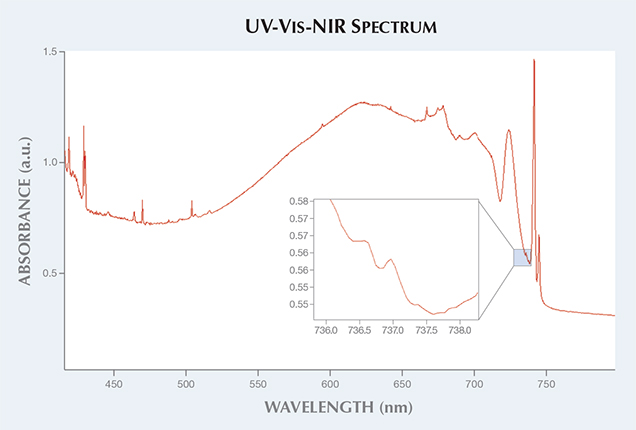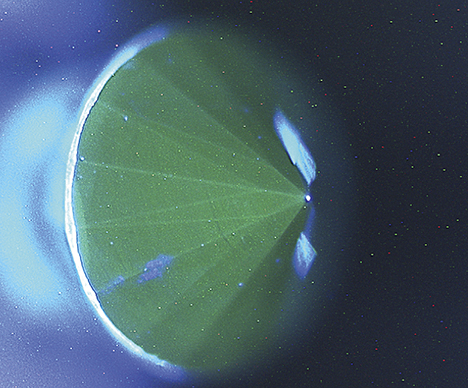Heavily Irradiated CVD Synthetic Diamond

A Fancy Deep gray-blue diamond weighing 0.46 ct was submitted to the Carlsbad lab for an identification and origin report. Its UV-Vis-NIR spectrum showed a large GR1 center, indicating artificial irradiation. Furthermore, a small 737 nm silicon doublet was seen and later confirmed with photoluminescence (PL) spectroscopy (figure 1). The silicon doublet is a feature in CVD synthetic diamonds, and only very rarely in natural diamonds.
To confirm the synthetic origin of the material, DiamondView images were collected. This required setting the DiamondView at the highest exposure time, because heavily irradiated diamonds tend to show very weak fluorescence, making the image difficult to resolve. The DiamondView image showed a pattern of growth dislocations, which is characteristic of CVD synthetics (figure 2). The infrared spectrum showed some unknown features in the nitrogen region at 1250 and 1116 cm−1. The infrared spectrum lacked the 3123 cm–1 hydrogen-related defect diagnostic of CVD growth (P.M. Martineau et al., “Identification of synthetic diamond grown using chemical vapor deposition [CVD],” Spring 2004 G&G, pp. 2–25), or the 3107 cm–1 peak sometimes created in synthetic diamonds containing hydrogen by HPHT treatment (I. Kiflawi et al., “The creation of the 3107 cm−1 hydrogen absorption peak in synthetic diamond single crystals,” Diamond and Related Materials, Vol. 5, 1996, pp. 1516–1518).

CVD synthetic diamonds are known to be treated post-growth to improve color, but this has been seen as HPHT treatment or a combination of irradiation and annealing. HPHT treatment of a CVD synthetic diamond can partially or completely remove a brownish color created during the growth process. If a CVD synthetic is grown with nitrogen impurities, irradiation and annealing will create nitrogen-vacancy centers, producing a pink to red color (J. Shigley et al., “Lab-grown colored diamonds from Chatham Created Gems,” Summer 2004 G&G, pp. 128–145).
This is the first CVD synthetic examined at GIA that has been irradiated to a blue color. The fact that the diamond is synthetic automatically means that the irradiation was done in a laboratory; however, the material displayed color zoning near the culet in a manner identical to natural diamonds that have been irradiated artificially. Electron paramagnetic resonance determined a 20 (+/- 5) ppb concentration of isolated nitrogen. If the specimen were to be annealed, the vacancies would combine with the nitrogen to form NV– centers, as mentioned above. It is possible that the diamond was submitted in an intermediate phase before the final treatment, or that the owner believed it to be a natural but treated stone. Indeed, in the absence of PL spectroscopy and DiamondView images, this specimen could easily be mistaken for an irradiated natural diamond.
As CVD synthetics become more prevalent and subject to a wider variety of treatments, it will only reinforce the role of the gemological laboratory as the most reliable way to separate synthetic from natural diamonds.



